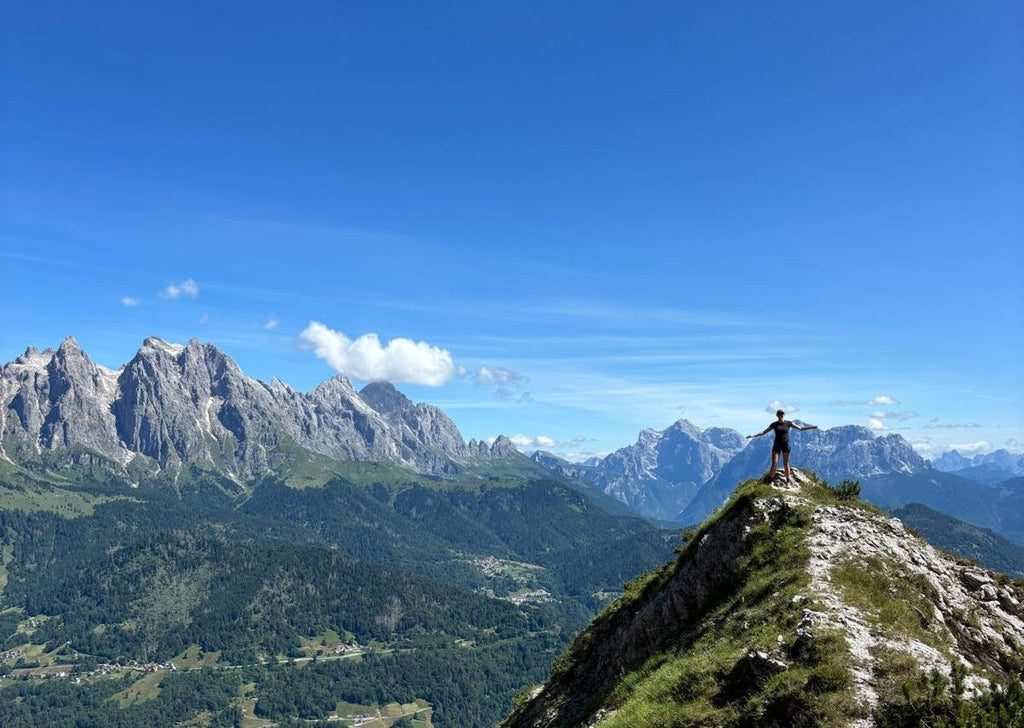Hiking in the Dolomites

Italy’s Mountains of Light
The Dolomites sit in northern Italy, stretching across South Tyrol and Trentino. Their pale cliffs catch the sun through the day, turning from grey to soft gold as light shifts. It’s a region that mixes Austrian precision with Italian ease - crisp mornings, long lunches, and open horizons.
For travellers who love the Mediterranean but want cooler air, this is the balance. Think alpine mornings, Italian afternoons, and the kind of clear streams where you can dip your feet before drying off with your Lost Sol towel.
The Heart of Val di Fassa
Start in Vigo di Fassa, one of the best bases for exploring the central Dolomites. The Catinaccio group rises sharply above town, its limestone towers changing colour with every hour.
Take the Ciampedie cable car and begin the gentle hike past Rifugio Gardeccia to Rifugio Vajolet. It takes about two to three hours at a relaxed pace, with pine forest, waterfalls, and steady views along the way. Stay overnight if you can. Evenings in the huts are quiet and communal - simple food, mountain air, and that sense of being far from everything else.
The Towers Up Close
The next morning, set out early for Rifugio Re Alberto, about 90 minutes above Vajolet. From there, you’re standing beneath the spires of Torri del Vajolet - some of the Dolomites’ most striking peaks. The view opens to ridgelines that stretch for miles.
If you’re up for more, continue to Passo Santner for a high route that looks across the Catinaccio range. Then descend back to Vajolet for a second night, or loop down through Gardeccia toward Vigo.
You can find route maps and hut details on the Dolomiti Val di Fassa site.
Short Trips, Long Memories
If you have a few more days, drive north to Lago di Braies or spend a night in Cortina d’Ampezzo. The Dolomites are compact enough to explore in sections. Each valley has its own rhythm - some filled with wildflower meadows, others edged by lakes that stay icy even in July.
You don’t need to plan every detail. The mountain huts serve hearty food, trails are well marked, and even short walks lead to views worth the climb.
Lost Sol in the Dolomites
Near Torri del Vajolet, streams run down from the cliffs into small, clear pools. You can swim here in summer, though the water stays cold even on warm days. It’s a quiet corner of the Dolomites where the air smells of pine and the sound of the water fills the valley. Spread out your Lost Sol towel on the rocks and take a break before the next climb.
Lost Sol in the Dolomites on Instagram.
The Dolomite Rhythm
Each day here follows its own slow order - climb, eat, rest, repeat. You don’t need much more than good shoes, time, and space to notice the light changing.
By evening, there’s strudel on the table and the scent of pine in the air. The kind of quiet that lingers.
Pack light, bring your Lost Sol, and go find your own rhythm in the mountains.
FAQ
When is the best time to hike in the Dolomites?
June to September offers warm days and open trails. Early July brings wildflowers; September is quieter and cooler.
Can you swim in the lakes and streams?
You can dip in most alpine lakes and rivers, but the water is cold. Most hikers wade or cool off briefly rather than swim.
Where should I stay?
Vigo di Fassa, Ortisei, and Corvara all make good bases with easy access to trails, lifts, and food.
How do I reach the Dolomites?
Fly into Venice, Verona, or Innsbruck, then rent a car. The drive to Val di Fassa takes around three hours.